Displaying items by tag: Kitesurfing
Branson To Lead Largest Parade of Kitesurfers Record Bid
Hayling Island in the UK is the venue next month for an attempt for the Largest Parade of Kitesurfers at one time. The aim is to get over 400 kiters out on the water to break the current world record of 352 kiters set in Tarifa, Spain last year.
The record will be adjudicated by the GUINNESS WORLD RECORDS office.
The event was scheduled to take place over one of three weekends during September and October, depending on weather conditions.
So far the conditions have been against the attempt and a decision was taken today that conditions for the second of the possible weekends (2-4 October) are also not promising - therefore the Virgin Kitesurfing Armada Festival will DEFINITELY be staged on the 16-18 October 2015.
Get Up To Speed As Ireland's Surfing Season Begins
#Surfing - Summer might already be a distant memory, but Ireland's surfing season is only just getting under way.
And beyond the bigger wave hotspots like Sligo, which is set to host record-breaker Garrett McNamara at the second Surf Summit this November, there's a wealth of activity happening all around the Irish coast.
Entertainment.ie brings us a round-up of some of the best places for surfing action for all ability levels, including perhaps lesser-known haunts like the Sunny South East.
But the biggest attraction this month is surely the Battle for the Lake kitesurfing festival on Achill Island next weekend (25-27 September), with its entertaining mix of live music from up-and-coming homegrown acts and dazzling displays by Ireland's top kitesurfers.
Young Kitesurfers Fly The Banner For West Cork
#Kitesurfing - West Cork is firmly behind two junior stars of the Irish kitesurfing scene, as the Southern Star reports.
Fifteen-year-old James Tidmarsh, already a four-year veteran, was victorious in the junior competition at the recent Battle for the Bay on Dollymount Strand, where his fellow West Cork kiteboarder Darragh O'Brien (10) placed joint third.
The latter result is even more remarkable given that O'Brien has been kitesurfing for less than a year, and the Battle for the Bay was his first competition.
The Southern Star has more on the story HERE.
#Kitesurfing - It's Battle for the Bay time on Dollymount Strand this weekend (23-24 May), and The 42 brings us a preview of the kitesurfing action you can expect on Bull Island today and tomorrow.
Cheering on the competitors from the beach will be Irish medal winner Jade O'Connor, who's currently campaigning for a spot at a future Olympics when the sport makes its debut (potentially at Tokyo 2020).
And in her role as ambassador, O'Connor also has high praise some of the other action in Dublin Bay's waters, via the related discipline of boardercross – essentially kitesurfing on an obstacle course – and the crowd-pleasing freestylers.
“It’s really visual and it’s about jumping really high, like up to 20 metres in the air and doing tricks,” says the current British Ladies Champion.
The 42 has more on the story HERE.
#kitesurf – Dublin based Kiteboarder Jade O'Connor was named 'Woman Of The Year 2014' at Outsider Magazines Awards last night. She had an outstanding year which saw her achieve eighth overall at the Worlds, fourth at the Europeans, and is the current British Ladies Champion. Jade competes in ISAF's Formula Kiteboarding Class which was showcased at ISAF Abu Dhabi Grand Finale last November, and is now included along side the 10 Olympic Classes at future ISAF World Cup events.
Jade said "I'm over the moon' to collect the award. It's a huge honour in light of the amazing achievements of the other athletes and adventurers nominated. This kicks my 2015 race season off with a bang of good energy". Having recently added goldenpages.ie as sponsors along side PureMagic she is excited to mount a full campaign representing Ireland at ISAF and Championship events this year. Her first event is Palma's SAR Princesa Sofia Regatta in March, which is a pre-qualifier for Sailing World Cup Hyeres the following Month.
The Outsider Magazine Awards showcases Athletes, Adventurers, Photographers, Videographers, Event Organisers and Adventure Companies who complete incredible feats or contribute to outdoor life on home soil or abroad. It's a celebration of the diversity and outdoor achievement, binding many individuals under a common banner of striving to do great things in their chosen field.
Some of the people honoured this year include -
Person of the Year 2014 - Tony Mangan, ultra runner
He ran the whole way around the world and longer than anyone else has ever run. His feat is the equivalent of 1,200 marathons.
Lifetime Achievement Award - Maurice Mullins
Pioneer, forward thinker, influencer, legend; all words used to describe Maurice Mullins, the man who introduced triathlon events to Ireland.
Kitesurfers Donate £5,000 to the RNLI
#kitesurf – A group from the Virgin Kitesurfing Armada team visited the Hayling Island RNLI station in the UK yesterday to present them with a £5,000 cheque from funds raised at last years event.
Lifeboat Operations Manager, Jonathan Bradbury received the cheque and said, 'We want to say a sincere thank you to all the kitesurfers who participated in the Armada and raised this fantastic amount. We are currently aiming to kit out the entire crew here with new drysuits, specialist helmets and gloves and this will go a along way to achieving this goal, making us more effective on the water in rescue situations.'
Mr Bradbury also explained how the Hayling RNLI branch was effectively founded after a rescue which took place 150 years ago today, and also joked, 'to be honest these days we actually have more trouble from windsurfers than kitesurfers...'
Dan Charlish from the Virgin Kitesurfing Armada said, 'Knowing the RNLI are there gives me, and I'm sure many other kitesurfers, a lot of reassurance. They do an amazing job and it's great that the kitesurfing community can come together once a year and support their work.'
Dan also thanked the volunteers for their fantastic commitment to the event, the sponsors and kitesurfing industry for getting behind the Armada and Havant Borough Council for their ongoing support and partnership.
Sarah Flamson of Havant Borough Council attended the presentation and said, 'We are fully behind the goals of the Kitesurfing Armada and it brings so much to Hayling Island - we are looking forward to working with the team to make the event even better this year.'
Dollymount Car Ban Runs Afoul Of Ireland's Kitesurfers
#Dollymount - The news earlier this week that the temporary parking ban on Dollymount Strand will be made permanent has sent ripples among Ireland's kitesurfing community – many of whom are said to be snubbing what was a popular site for the sport in Dublin Bay.
That's according to Herald.ie, which also reports that the increase of kitesurfing visitors among other beachgoers "has created pressures with regard to maintenance, public order and safety" that prompted the car ban by Dublin City Council.
Nicola Murphy, secretary of the Irish Kite Surfing Association (ISKA), said the body wants to fully co-operate with the council" on finding a solution that will restore road access to the beach for its members.
Herald.ie has more on the story HERE.
#Kitesurfing - The Sunday Independent profiles top kitesurfing prospect Katie McAnena ahead of next weekend's Battle for the Bay on Dollymount Strand.
Kitesurfers and stand-up paddle boarders from around the world will converge on Bull Island in Dublin Bay from 24-25 May for the annual championships, which are now in their eighth year.
And Galway native McAnena will be making her first appearance at the event, a year after becoming the first woman surfer to take on the infamous 'Jaws' wave in Hawaii.
But despite her world travels, the qualified doctor - who grew up windsurfing in Rusheen Bay - believes the Irish have "bigger, heavier waves here in Ireland right at our back door".
Independent.ie has more on the story HERE.
#kitesurfing – 2014 will see Jade O'Connor continue to campaign in the Formula Kiteboard class after the Dubliner represented Ireland last year at The Kiteboard Racing World Championships in China. She finished 12th overall, her best result to date.
"This is a big year for our class, in light of our exclusion from Rio 2016. The IKA and ISAF are in negotiation for the 2020 Olympics. To that end, kiting will be included in the new next month at the Delta Lloyd EUROSAF in the Netherlands, this will be an invitational event of only 20 sailors, so it's a big honour to be chosen, and have Ireland on the start line." O'Connor told Afloat.ie
Apart from ISAF's own events kiteboarding has a highly successful world tour that will see the Dubliner compete in Turkey, Poland, San Diego, Qatar, and finishing the year in Sydney Australia. "It's amazing to be part of the tour and compete at this level. The last month has been about loosening up and getting back into the groove, when racing with 30knots of board speed you have to rely more on muscle memory, and 'get your head out of the boat' so to speak. Now I'm dialling into new equipment and starting to look for improvements in board handling, chop management, upwind angle and speed. As one of the few amateurs at this level its difficult to compete at my best all season. I've picked the Worlds in August and Sydney in December to be my standout events, I'm really excited to get going, I can feel that coiled spring in my stomach starting to wind."
Kitesurfer Jade Scores Personal Best at Chinese World Championships
#kitesurf – After 61 races over 5 days, with 150 sailors from 45 countries the IKA Kiteboard Racing World Championship drew to a close yesterday.
Florian Gruber from Germany took the crown from ISAF Sailor of the year nominee Johnny Heineken in convincing style as lightwinds dominated the final two days of the event. Erika Heineken continues to reign as the Ladies World Championship, with a near flawless set of bullets.
Irish Rider Jade O'Connor. Finished in 12th position overall in the ladies fleet. Up 15 places from 27th in last years World Championships in Sardinia.
"Its been an amazing year for me, I started my season in Egypt at the African Championships in March and have improved every event since.
My goal for this year was top 20 and I've blown that out of the water. I'm amp'd for the new season to start and know exactly what I have to do to improve. Special thanks to my friends, family and sponsors for all the support" she said earlier.



























